Business Finance: Emilia's Budgeting Methods and Analysis Report
VerifiedAdded on 2020/02/03
|12
|3940
|29
Report
AI Summary
This report provides a comprehensive analysis of budgeting methods in business finance, focusing on Emilia's business. It begins with an introduction to finance and the importance of budgeting, outlining the purposes and objectives of budget preparation, such as forecasting income, facilitating decision-making, and monitoring performance. The report then delves into traditional budgeting, explaining its application, structure, advantages (like control and organizational integration), and weaknesses (such as inflexibility). The second part of the report contrasts traditional budgeting with alternative methods like incremental, zero-based, and priority-based budgeting, along with decision conferencing. The report highlights the strengths and weaknesses of each method, providing a well-rounded understanding of budgeting techniques for financial management.
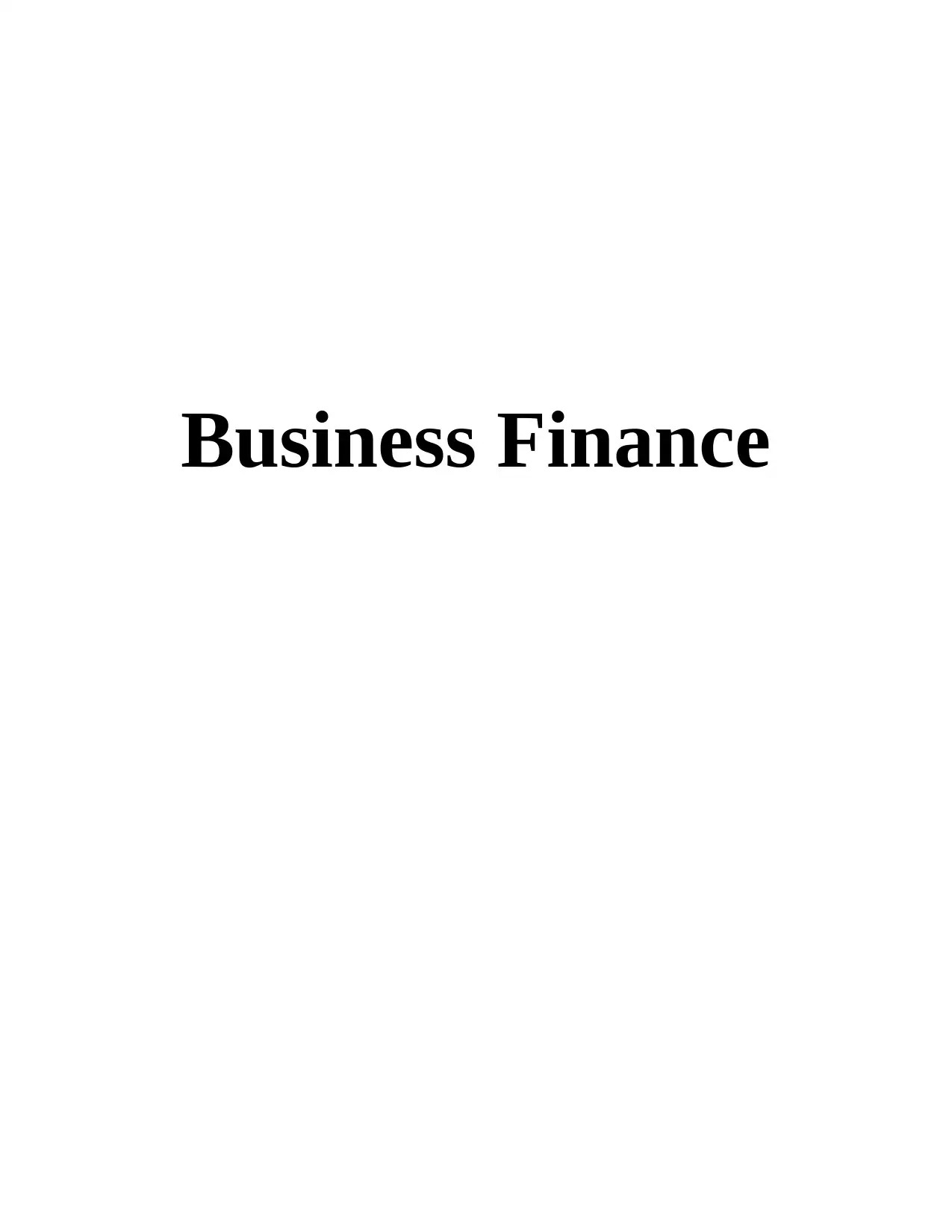
Business Finance
Paraphrase This Document
Need a fresh take? Get an instant paraphrase of this document with our AI Paraphraser
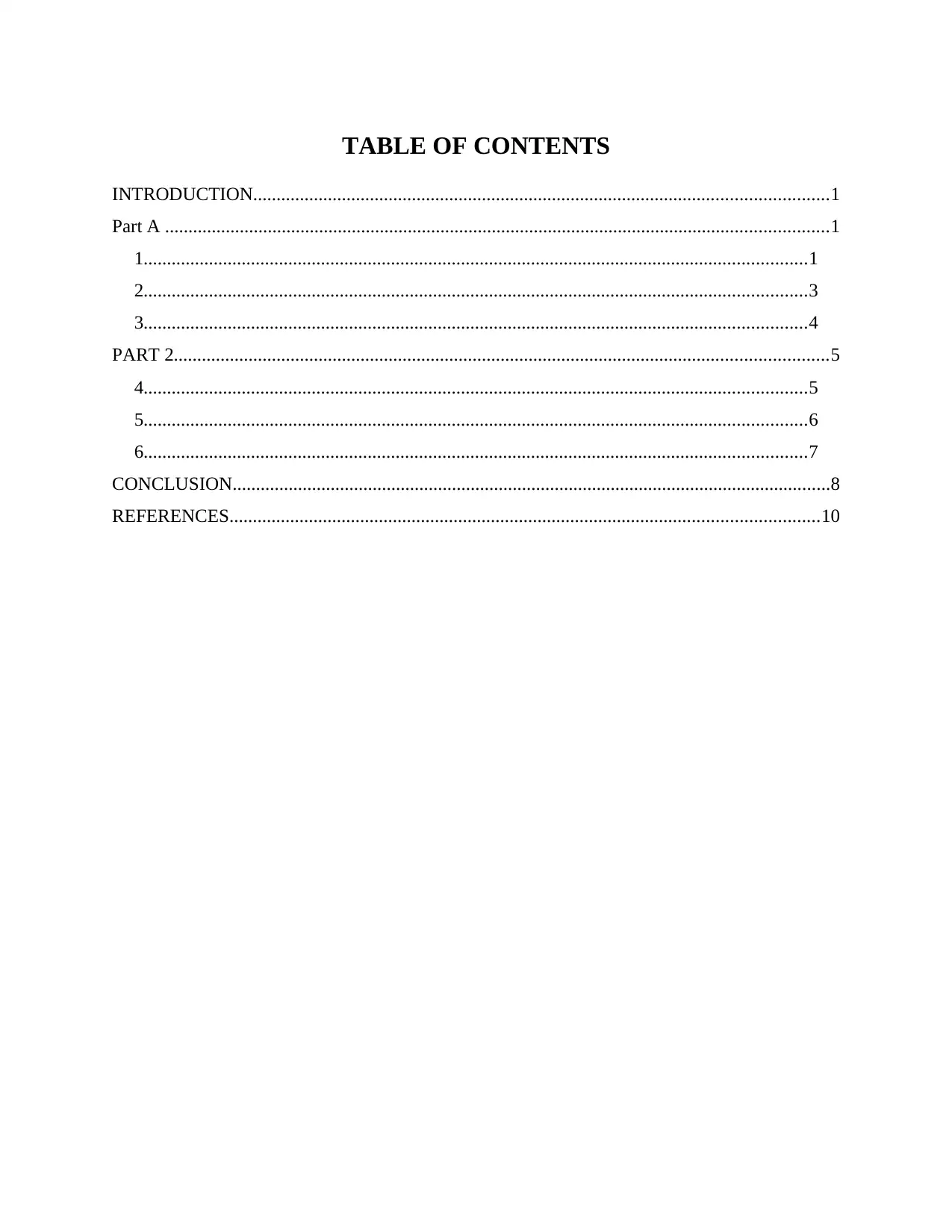
TABLE OF CONTENTS
INTRODUCTION...........................................................................................................................1
Part A ..............................................................................................................................................1
1..............................................................................................................................................1
2..............................................................................................................................................3
3..............................................................................................................................................4
PART 2............................................................................................................................................5
4..............................................................................................................................................5
5..............................................................................................................................................6
6..............................................................................................................................................7
CONCLUSION................................................................................................................................8
REFERENCES..............................................................................................................................10
INTRODUCTION...........................................................................................................................1
Part A ..............................................................................................................................................1
1..............................................................................................................................................1
2..............................................................................................................................................3
3..............................................................................................................................................4
PART 2............................................................................................................................................5
4..............................................................................................................................................5
5..............................................................................................................................................6
6..............................................................................................................................................7
CONCLUSION................................................................................................................................8
REFERENCES..............................................................................................................................10

INTRODUCTION
Finance acts like a life blood for an enterprise as it is that resource which is required by
every enterprise in order to uplift their overall situations. Arranging financial resources is a
major element involved in the business so as is for the organisation. Emilia has been selected for
this project report and its importance has been explained throughout the report. This project is all
about budgeting and their different approaches which help an enterprise in order to maintain
consistency in their overall performance. The major emphasis of this project report is describing
various budget methodologies and their applications in the current business organisation Several
traditional budgeting methods have also been enclosed (Ambrosini and Jenkins, 2015).
Part A
1
A budget is a quantitative expression of a plan for a defined period as it includes planned sales
volumes and revenues, resources quantities, costs and expenses, assets, liabilities and cash flows.
When any company is about to establish a new business, then preliminary step is to make budget
(Asongu, 2016). In this case the budget of Emilia's business is handled by Nadia, who is the
CFO. Behind formulation of the budget there are some purposes and objective which are given
as below:
PURPOSE of budget preparation
In context of business management, the purpose of budgeting includes the following
aspects :
Forecast income and expenditures: The main purpose of budgeting is to forecast the
expenditures that will be incurred during the project in order to generate higher level of income.
In this case Nadia should make that type of budget where he can determine the income that can
be generated in the hospital.
Tool for decision making: With the help of budget preparation Nadia can easily take the other
finance related decisions and can relax from that burden (Arrfelt and Wiseman, 2015).
1
Finance acts like a life blood for an enterprise as it is that resource which is required by
every enterprise in order to uplift their overall situations. Arranging financial resources is a
major element involved in the business so as is for the organisation. Emilia has been selected for
this project report and its importance has been explained throughout the report. This project is all
about budgeting and their different approaches which help an enterprise in order to maintain
consistency in their overall performance. The major emphasis of this project report is describing
various budget methodologies and their applications in the current business organisation Several
traditional budgeting methods have also been enclosed (Ambrosini and Jenkins, 2015).
Part A
1
A budget is a quantitative expression of a plan for a defined period as it includes planned sales
volumes and revenues, resources quantities, costs and expenses, assets, liabilities and cash flows.
When any company is about to establish a new business, then preliminary step is to make budget
(Asongu, 2016). In this case the budget of Emilia's business is handled by Nadia, who is the
CFO. Behind formulation of the budget there are some purposes and objective which are given
as below:
PURPOSE of budget preparation
In context of business management, the purpose of budgeting includes the following
aspects :
Forecast income and expenditures: The main purpose of budgeting is to forecast the
expenditures that will be incurred during the project in order to generate higher level of income.
In this case Nadia should make that type of budget where he can determine the income that can
be generated in the hospital.
Tool for decision making: With the help of budget preparation Nadia can easily take the other
finance related decisions and can relax from that burden (Arrfelt and Wiseman, 2015).
1
⊘ This is a preview!⊘
Do you want full access?
Subscribe today to unlock all pages.

Trusted by 1+ million students worldwide
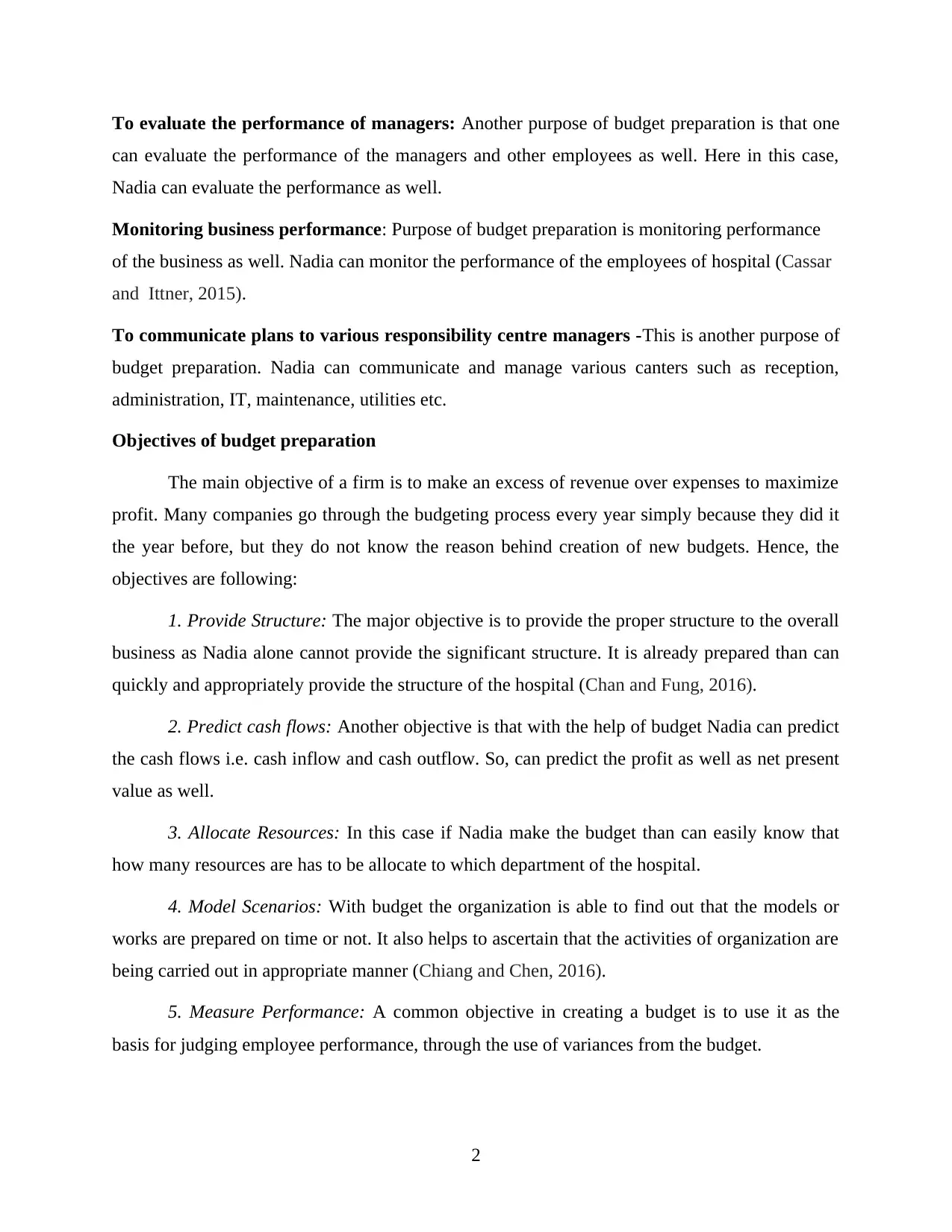
To evaluate the performance of managers: Another purpose of budget preparation is that one
can evaluate the performance of the managers and other employees as well. Here in this case,
Nadia can evaluate the performance as well.
Monitoring business performance: Purpose of budget preparation is monitoring performance
of the business as well. Nadia can monitor the performance of the employees of hospital (Cassar
and Ittner, 2015).
To communicate plans to various responsibility centre managers -This is another purpose of
budget preparation. Nadia can communicate and manage various canters such as reception,
administration, IT, maintenance, utilities etc.
Objectives of budget preparation
The main objective of a firm is to make an excess of revenue over expenses to maximize
profit. Many companies go through the budgeting process every year simply because they did it
the year before, but they do not know the reason behind creation of new budgets. Hence, the
objectives are following:
1. Provide Structure: The major objective is to provide the proper structure to the overall
business as Nadia alone cannot provide the significant structure. It is already prepared than can
quickly and appropriately provide the structure of the hospital (Chan and Fung, 2016).
2. Predict cash flows: Another objective is that with the help of budget Nadia can predict
the cash flows i.e. cash inflow and cash outflow. So, can predict the profit as well as net present
value as well.
3. Allocate Resources: In this case if Nadia make the budget than can easily know that
how many resources are has to be allocate to which department of the hospital.
4. Model Scenarios: With budget the organization is able to find out that the models or
works are prepared on time or not. It also helps to ascertain that the activities of organization are
being carried out in appropriate manner (Chiang and Chen, 2016).
5. Measure Performance: A common objective in creating a budget is to use it as the
basis for judging employee performance, through the use of variances from the budget.
2
can evaluate the performance of the managers and other employees as well. Here in this case,
Nadia can evaluate the performance as well.
Monitoring business performance: Purpose of budget preparation is monitoring performance
of the business as well. Nadia can monitor the performance of the employees of hospital (Cassar
and Ittner, 2015).
To communicate plans to various responsibility centre managers -This is another purpose of
budget preparation. Nadia can communicate and manage various canters such as reception,
administration, IT, maintenance, utilities etc.
Objectives of budget preparation
The main objective of a firm is to make an excess of revenue over expenses to maximize
profit. Many companies go through the budgeting process every year simply because they did it
the year before, but they do not know the reason behind creation of new budgets. Hence, the
objectives are following:
1. Provide Structure: The major objective is to provide the proper structure to the overall
business as Nadia alone cannot provide the significant structure. It is already prepared than can
quickly and appropriately provide the structure of the hospital (Chan and Fung, 2016).
2. Predict cash flows: Another objective is that with the help of budget Nadia can predict
the cash flows i.e. cash inflow and cash outflow. So, can predict the profit as well as net present
value as well.
3. Allocate Resources: In this case if Nadia make the budget than can easily know that
how many resources are has to be allocate to which department of the hospital.
4. Model Scenarios: With budget the organization is able to find out that the models or
works are prepared on time or not. It also helps to ascertain that the activities of organization are
being carried out in appropriate manner (Chiang and Chen, 2016).
5. Measure Performance: A common objective in creating a budget is to use it as the
basis for judging employee performance, through the use of variances from the budget.
2
Paraphrase This Document
Need a fresh take? Get an instant paraphrase of this document with our AI Paraphraser
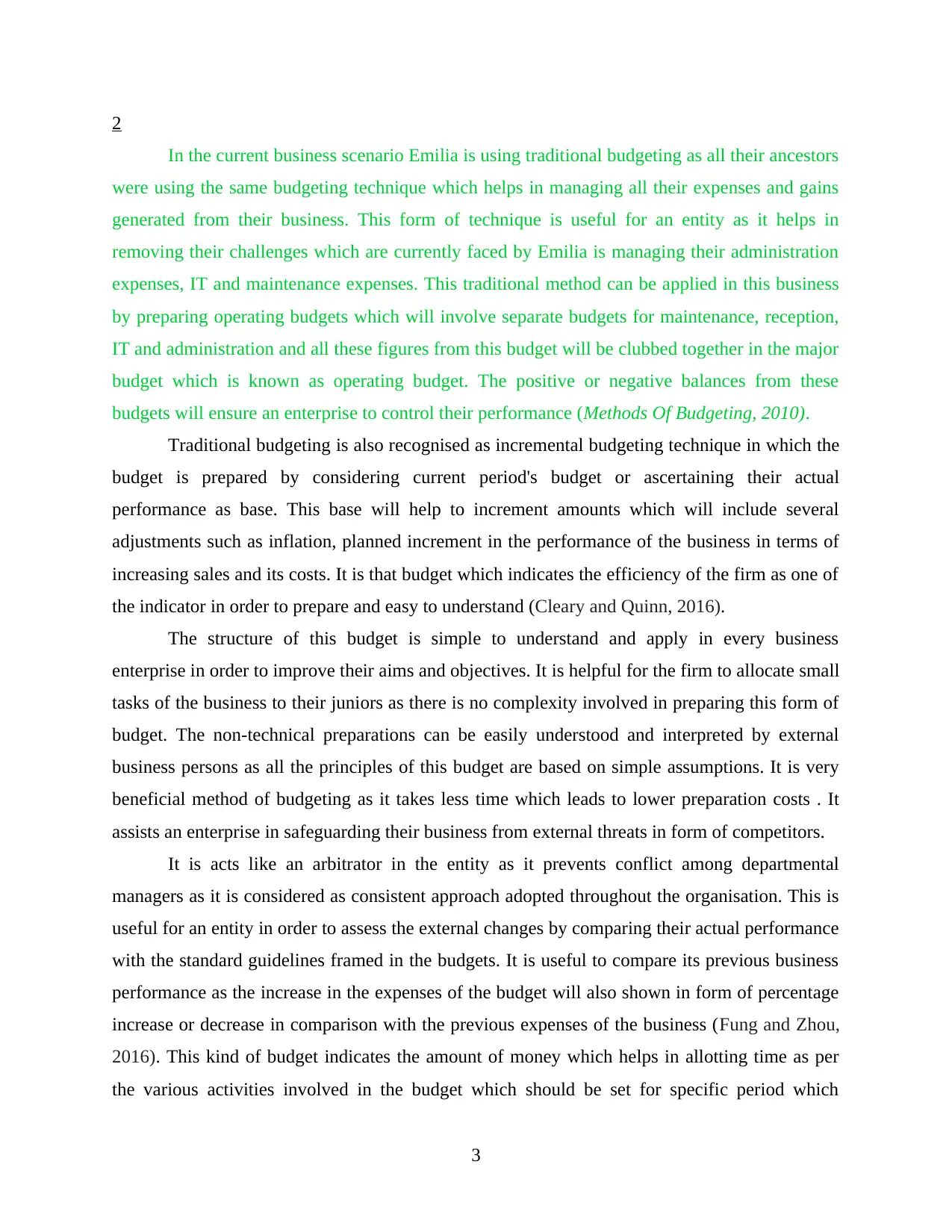
2
In the current business scenario Emilia is using traditional budgeting as all their ancestors
were using the same budgeting technique which helps in managing all their expenses and gains
generated from their business. This form of technique is useful for an entity as it helps in
removing their challenges which are currently faced by Emilia is managing their administration
expenses, IT and maintenance expenses. This traditional method can be applied in this business
by preparing operating budgets which will involve separate budgets for maintenance, reception,
IT and administration and all these figures from this budget will be clubbed together in the major
budget which is known as operating budget. The positive or negative balances from these
budgets will ensure an enterprise to control their performance (Methods Of Budgeting, 2010).
Traditional budgeting is also recognised as incremental budgeting technique in which the
budget is prepared by considering current period's budget or ascertaining their actual
performance as base. This base will help to increment amounts which will include several
adjustments such as inflation, planned increment in the performance of the business in terms of
increasing sales and its costs. It is that budget which indicates the efficiency of the firm as one of
the indicator in order to prepare and easy to understand (Cleary and Quinn, 2016).
The structure of this budget is simple to understand and apply in every business
enterprise in order to improve their aims and objectives. It is helpful for the firm to allocate small
tasks of the business to their juniors as there is no complexity involved in preparing this form of
budget. The non-technical preparations can be easily understood and interpreted by external
business persons as all the principles of this budget are based on simple assumptions. It is very
beneficial method of budgeting as it takes less time which leads to lower preparation costs . It
assists an enterprise in safeguarding their business from external threats in form of competitors.
It is acts like an arbitrator in the entity as it prevents conflict among departmental
managers as it is considered as consistent approach adopted throughout the organisation. This is
useful for an entity in order to assess the external changes by comparing their actual performance
with the standard guidelines framed in the budgets. It is useful to compare its previous business
performance as the increase in the expenses of the budget will also shown in form of percentage
increase or decrease in comparison with the previous expenses of the business (Fung and Zhou,
2016). This kind of budget indicates the amount of money which helps in allotting time as per
the various activities involved in the budget which should be set for specific period which
3
In the current business scenario Emilia is using traditional budgeting as all their ancestors
were using the same budgeting technique which helps in managing all their expenses and gains
generated from their business. This form of technique is useful for an entity as it helps in
removing their challenges which are currently faced by Emilia is managing their administration
expenses, IT and maintenance expenses. This traditional method can be applied in this business
by preparing operating budgets which will involve separate budgets for maintenance, reception,
IT and administration and all these figures from this budget will be clubbed together in the major
budget which is known as operating budget. The positive or negative balances from these
budgets will ensure an enterprise to control their performance (Methods Of Budgeting, 2010).
Traditional budgeting is also recognised as incremental budgeting technique in which the
budget is prepared by considering current period's budget or ascertaining their actual
performance as base. This base will help to increment amounts which will include several
adjustments such as inflation, planned increment in the performance of the business in terms of
increasing sales and its costs. It is that budget which indicates the efficiency of the firm as one of
the indicator in order to prepare and easy to understand (Cleary and Quinn, 2016).
The structure of this budget is simple to understand and apply in every business
enterprise in order to improve their aims and objectives. It is helpful for the firm to allocate small
tasks of the business to their juniors as there is no complexity involved in preparing this form of
budget. The non-technical preparations can be easily understood and interpreted by external
business persons as all the principles of this budget are based on simple assumptions. It is very
beneficial method of budgeting as it takes less time which leads to lower preparation costs . It
assists an enterprise in safeguarding their business from external threats in form of competitors.
It is acts like an arbitrator in the entity as it prevents conflict among departmental
managers as it is considered as consistent approach adopted throughout the organisation. This is
useful for an entity in order to assess the external changes by comparing their actual performance
with the standard guidelines framed in the budgets. It is useful to compare its previous business
performance as the increase in the expenses of the budget will also shown in form of percentage
increase or decrease in comparison with the previous expenses of the business (Fung and Zhou,
2016). This kind of budget indicates the amount of money which helps in allotting time as per
the various activities involved in the budget which should be set for specific period which
3
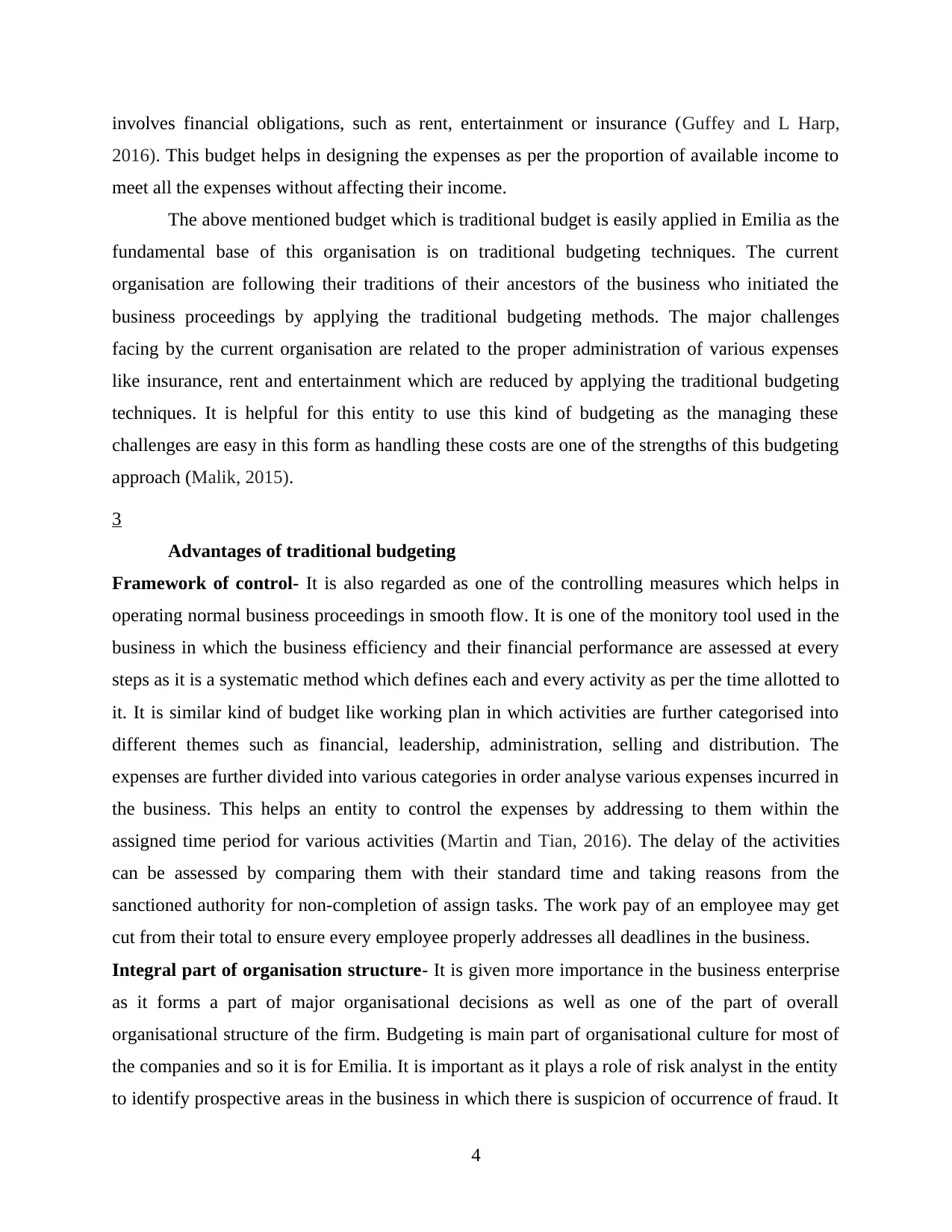
involves financial obligations, such as rent, entertainment or insurance (Guffey and L Harp,
2016). This budget helps in designing the expenses as per the proportion of available income to
meet all the expenses without affecting their income.
The above mentioned budget which is traditional budget is easily applied in Emilia as the
fundamental base of this organisation is on traditional budgeting techniques. The current
organisation are following their traditions of their ancestors of the business who initiated the
business proceedings by applying the traditional budgeting methods. The major challenges
facing by the current organisation are related to the proper administration of various expenses
like insurance, rent and entertainment which are reduced by applying the traditional budgeting
techniques. It is helpful for this entity to use this kind of budgeting as the managing these
challenges are easy in this form as handling these costs are one of the strengths of this budgeting
approach (Malik, 2015).
3
Advantages of traditional budgeting
Framework of control- It is also regarded as one of the controlling measures which helps in
operating normal business proceedings in smooth flow. It is one of the monitory tool used in the
business in which the business efficiency and their financial performance are assessed at every
steps as it is a systematic method which defines each and every activity as per the time allotted to
it. It is similar kind of budget like working plan in which activities are further categorised into
different themes such as financial, leadership, administration, selling and distribution. The
expenses are further divided into various categories in order analyse various expenses incurred in
the business. This helps an entity to control the expenses by addressing to them within the
assigned time period for various activities (Martin and Tian, 2016). The delay of the activities
can be assessed by comparing them with their standard time and taking reasons from the
sanctioned authority for non-completion of assign tasks. The work pay of an employee may get
cut from their total to ensure every employee properly addresses all deadlines in the business.
Integral part of organisation structure- It is given more importance in the business enterprise
as it forms a part of major organisational decisions as well as one of the part of overall
organisational structure of the firm. Budgeting is main part of organisational culture for most of
the companies and so it is for Emilia. It is important as it plays a role of risk analyst in the entity
to identify prospective areas in the business in which there is suspicion of occurrence of fraud. It
4
2016). This budget helps in designing the expenses as per the proportion of available income to
meet all the expenses without affecting their income.
The above mentioned budget which is traditional budget is easily applied in Emilia as the
fundamental base of this organisation is on traditional budgeting techniques. The current
organisation are following their traditions of their ancestors of the business who initiated the
business proceedings by applying the traditional budgeting methods. The major challenges
facing by the current organisation are related to the proper administration of various expenses
like insurance, rent and entertainment which are reduced by applying the traditional budgeting
techniques. It is helpful for this entity to use this kind of budgeting as the managing these
challenges are easy in this form as handling these costs are one of the strengths of this budgeting
approach (Malik, 2015).
3
Advantages of traditional budgeting
Framework of control- It is also regarded as one of the controlling measures which helps in
operating normal business proceedings in smooth flow. It is one of the monitory tool used in the
business in which the business efficiency and their financial performance are assessed at every
steps as it is a systematic method which defines each and every activity as per the time allotted to
it. It is similar kind of budget like working plan in which activities are further categorised into
different themes such as financial, leadership, administration, selling and distribution. The
expenses are further divided into various categories in order analyse various expenses incurred in
the business. This helps an entity to control the expenses by addressing to them within the
assigned time period for various activities (Martin and Tian, 2016). The delay of the activities
can be assessed by comparing them with their standard time and taking reasons from the
sanctioned authority for non-completion of assign tasks. The work pay of an employee may get
cut from their total to ensure every employee properly addresses all deadlines in the business.
Integral part of organisation structure- It is given more importance in the business enterprise
as it forms a part of major organisational decisions as well as one of the part of overall
organisational structure of the firm. Budgeting is main part of organisational culture for most of
the companies and so it is for Emilia. It is important as it plays a role of risk analyst in the entity
to identify prospective areas in the business in which there is suspicion of occurrence of fraud. It
4
⊘ This is a preview!⊘
Do you want full access?
Subscribe today to unlock all pages.

Trusted by 1+ million students worldwide
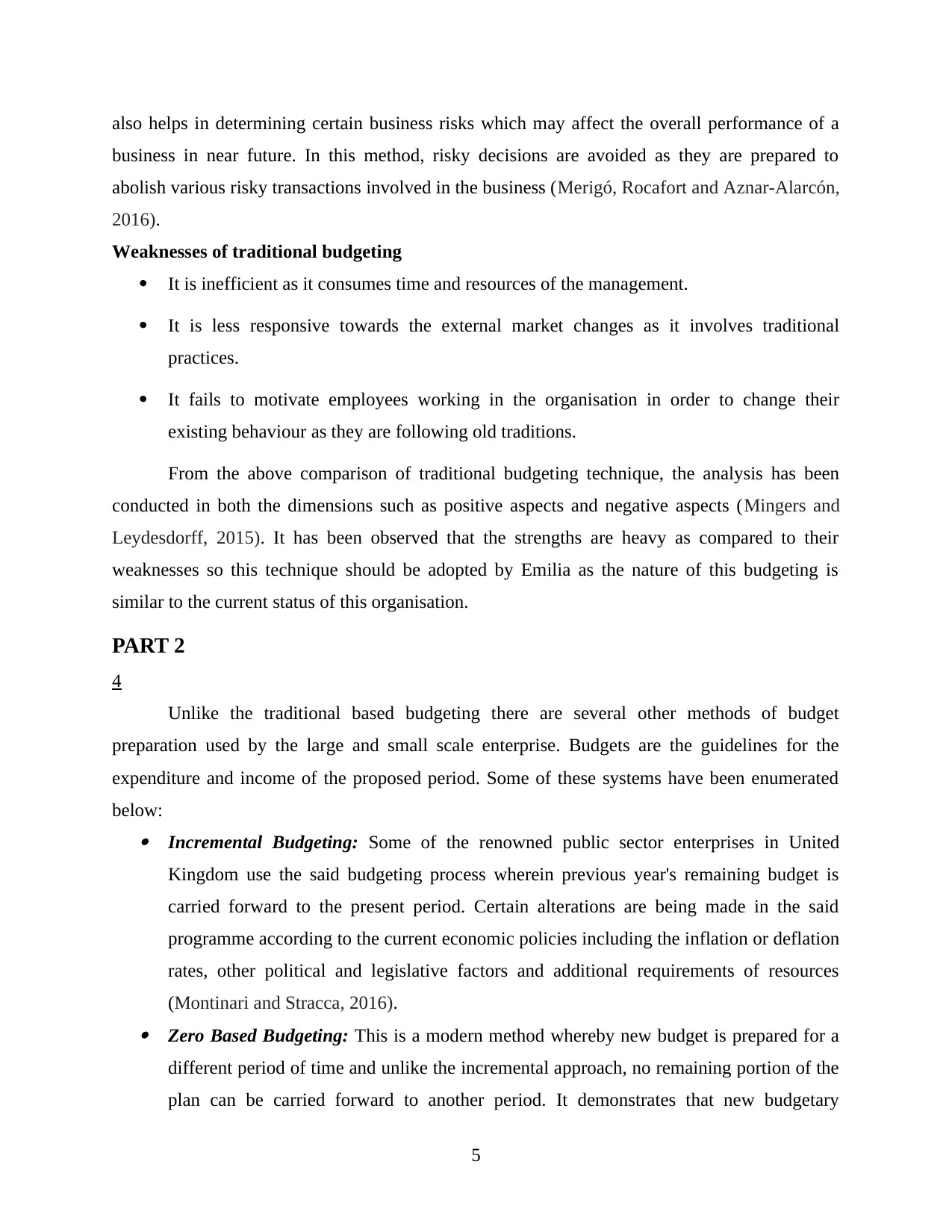
also helps in determining certain business risks which may affect the overall performance of a
business in near future. In this method, risky decisions are avoided as they are prepared to
abolish various risky transactions involved in the business (Merigó, Rocafort and Aznar-Alarcón,
2016).
Weaknesses of traditional budgeting
It is inefficient as it consumes time and resources of the management.
It is less responsive towards the external market changes as it involves traditional
practices.
It fails to motivate employees working in the organisation in order to change their
existing behaviour as they are following old traditions.
From the above comparison of traditional budgeting technique, the analysis has been
conducted in both the dimensions such as positive aspects and negative aspects (Mingers and
Leydesdorff, 2015). It has been observed that the strengths are heavy as compared to their
weaknesses so this technique should be adopted by Emilia as the nature of this budgeting is
similar to the current status of this organisation.
PART 2
4
Unlike the traditional based budgeting there are several other methods of budget
preparation used by the large and small scale enterprise. Budgets are the guidelines for the
expenditure and income of the proposed period. Some of these systems have been enumerated
below: Incremental Budgeting: Some of the renowned public sector enterprises in United
Kingdom use the said budgeting process wherein previous year's remaining budget is
carried forward to the present period. Certain alterations are being made in the said
programme according to the current economic policies including the inflation or deflation
rates, other political and legislative factors and additional requirements of resources
(Montinari and Stracca, 2016). Zero Based Budgeting: This is a modern method whereby new budget is prepared for a
different period of time and unlike the incremental approach, no remaining portion of the
plan can be carried forward to another period. It demonstrates that new budgetary
5
business in near future. In this method, risky decisions are avoided as they are prepared to
abolish various risky transactions involved in the business (Merigó, Rocafort and Aznar-Alarcón,
2016).
Weaknesses of traditional budgeting
It is inefficient as it consumes time and resources of the management.
It is less responsive towards the external market changes as it involves traditional
practices.
It fails to motivate employees working in the organisation in order to change their
existing behaviour as they are following old traditions.
From the above comparison of traditional budgeting technique, the analysis has been
conducted in both the dimensions such as positive aspects and negative aspects (Mingers and
Leydesdorff, 2015). It has been observed that the strengths are heavy as compared to their
weaknesses so this technique should be adopted by Emilia as the nature of this budgeting is
similar to the current status of this organisation.
PART 2
4
Unlike the traditional based budgeting there are several other methods of budget
preparation used by the large and small scale enterprise. Budgets are the guidelines for the
expenditure and income of the proposed period. Some of these systems have been enumerated
below: Incremental Budgeting: Some of the renowned public sector enterprises in United
Kingdom use the said budgeting process wherein previous year's remaining budget is
carried forward to the present period. Certain alterations are being made in the said
programme according to the current economic policies including the inflation or deflation
rates, other political and legislative factors and additional requirements of resources
(Montinari and Stracca, 2016). Zero Based Budgeting: This is a modern method whereby new budget is prepared for a
different period of time and unlike the incremental approach, no remaining portion of the
plan can be carried forward to another period. It demonstrates that new budgetary
5
Paraphrase This Document
Need a fresh take? Get an instant paraphrase of this document with our AI Paraphraser
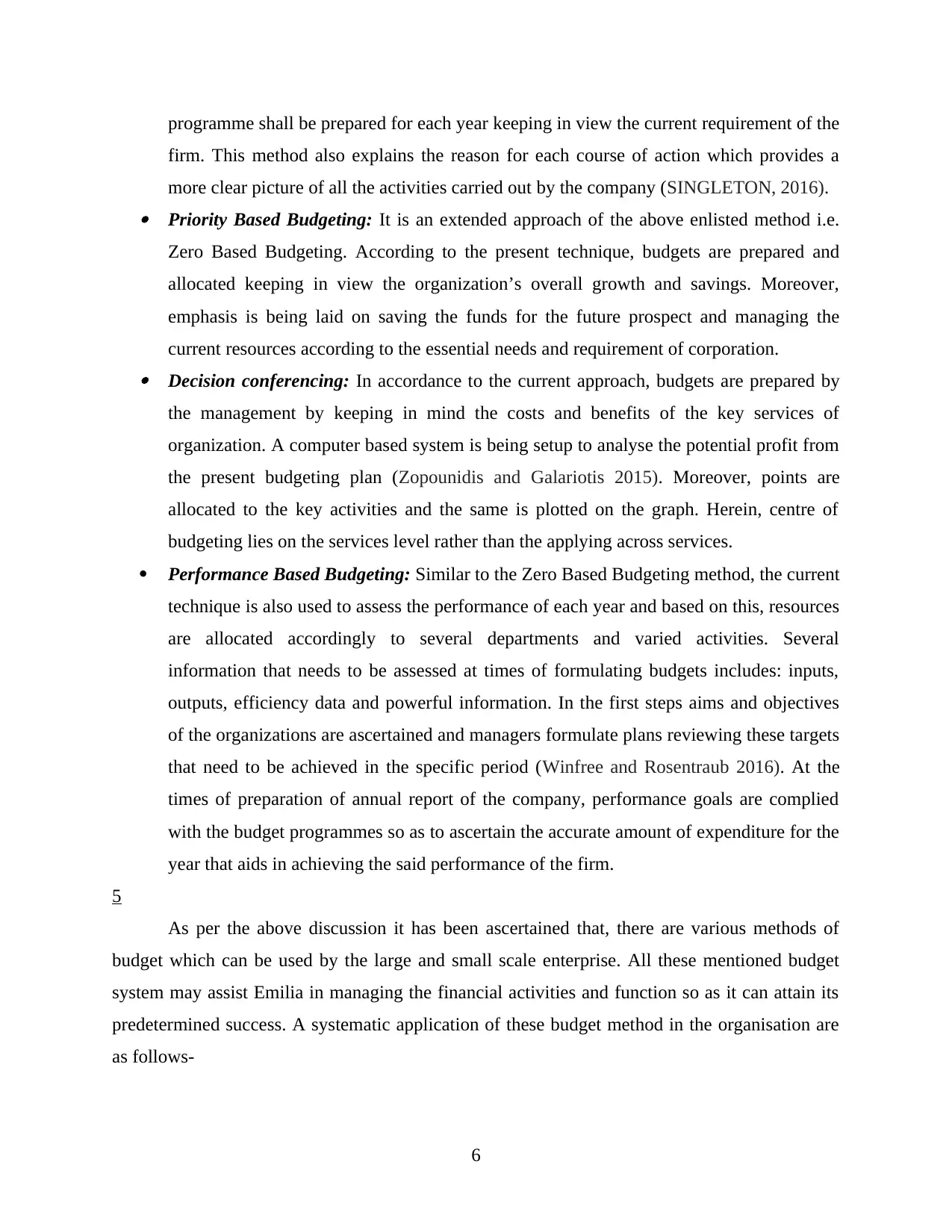
programme shall be prepared for each year keeping in view the current requirement of the
firm. This method also explains the reason for each course of action which provides a
more clear picture of all the activities carried out by the company (SINGLETON, 2016). Priority Based Budgeting: It is an extended approach of the above enlisted method i.e.
Zero Based Budgeting. According to the present technique, budgets are prepared and
allocated keeping in view the organization’s overall growth and savings. Moreover,
emphasis is being laid on saving the funds for the future prospect and managing the
current resources according to the essential needs and requirement of corporation. Decision conferencing: In accordance to the current approach, budgets are prepared by
the management by keeping in mind the costs and benefits of the key services of
organization. A computer based system is being setup to analyse the potential profit from
the present budgeting plan (Zopounidis and Galariotis 2015). Moreover, points are
allocated to the key activities and the same is plotted on the graph. Herein, centre of
budgeting lies on the services level rather than the applying across services.
Performance Based Budgeting: Similar to the Zero Based Budgeting method, the current
technique is also used to assess the performance of each year and based on this, resources
are allocated accordingly to several departments and varied activities. Several
information that needs to be assessed at times of formulating budgets includes: inputs,
outputs, efficiency data and powerful information. In the first steps aims and objectives
of the organizations are ascertained and managers formulate plans reviewing these targets
that need to be achieved in the specific period (Winfree and Rosentraub 2016). At the
times of preparation of annual report of the company, performance goals are complied
with the budget programmes so as to ascertain the accurate amount of expenditure for the
year that aids in achieving the said performance of the firm.
5
As per the above discussion it has been ascertained that, there are various methods of
budget which can be used by the large and small scale enterprise. All these mentioned budget
system may assist Emilia in managing the financial activities and function so as it can attain its
predetermined success. A systematic application of these budget method in the organisation are
as follows-
6
firm. This method also explains the reason for each course of action which provides a
more clear picture of all the activities carried out by the company (SINGLETON, 2016). Priority Based Budgeting: It is an extended approach of the above enlisted method i.e.
Zero Based Budgeting. According to the present technique, budgets are prepared and
allocated keeping in view the organization’s overall growth and savings. Moreover,
emphasis is being laid on saving the funds for the future prospect and managing the
current resources according to the essential needs and requirement of corporation. Decision conferencing: In accordance to the current approach, budgets are prepared by
the management by keeping in mind the costs and benefits of the key services of
organization. A computer based system is being setup to analyse the potential profit from
the present budgeting plan (Zopounidis and Galariotis 2015). Moreover, points are
allocated to the key activities and the same is plotted on the graph. Herein, centre of
budgeting lies on the services level rather than the applying across services.
Performance Based Budgeting: Similar to the Zero Based Budgeting method, the current
technique is also used to assess the performance of each year and based on this, resources
are allocated accordingly to several departments and varied activities. Several
information that needs to be assessed at times of formulating budgets includes: inputs,
outputs, efficiency data and powerful information. In the first steps aims and objectives
of the organizations are ascertained and managers formulate plans reviewing these targets
that need to be achieved in the specific period (Winfree and Rosentraub 2016). At the
times of preparation of annual report of the company, performance goals are complied
with the budget programmes so as to ascertain the accurate amount of expenditure for the
year that aids in achieving the said performance of the firm.
5
As per the above discussion it has been ascertained that, there are various methods of
budget which can be used by the large and small scale enterprise. All these mentioned budget
system may assist Emilia in managing the financial activities and function so as it can attain its
predetermined success. A systematic application of these budget method in the organisation are
as follows-
6

Incremental Budgeting- Emilia can prepare previous period's budget or actual
performance as a basis with incremental amount added for the new budget period. Emilia
manager can operate their department on a consistent basis. In the cited venture, as per
this method of budgeting, the allocation of resources is based upon allocation from the
previous period (Yvanovich, 2012). Zero Based Budgeting: In the Emilia, zero base budgeting prepare the budget from the
scratch with a zero base. Through this method, line item of cash flow statement are re-
evaluated and justified all the expenses that is to be incurred by the department. Further,
manager can calculate all the expenses for the new period on the basis of actual expenses
that are to be incurred and not on the incremental basis which involves just increasing the
expenses incurred in the previous year at some fixed rate. Priority Based Budgeting: In the Emilia organisation, this budget method provides a way
to compare community value with the program and services that a government entity
provides (Cleary and Quinn, 2016). It evaluates the impact of those goals on city
programs and services. Through this method, corporation can engage in strategies
decision making regarding funding for services and change to service levels for current
programs. Decision conferencing: With assistance of this budget method of finance, Emilia can
keep the cost and benefit of key services in the management. It can analyse the profit and
cost and calculate the points of various managerial activities.
Performance Based Budgeting- In the cited venture, performance based budgeting can
be applicable in order to assess the performance of every year. As per the assessment the
resources are allocated to the various department in the management. Manager of cited
venture can develop the plan and set the schedule to attain in the specific time period.
Further, company can set the goal and according to the target, allocation of resources can
be done (Chiang and Chen, 2016).
6
Budgets are prepared by every organization in order to ascertain the appropriate amount
of resources to execute all the relevant operations of an organization. These are kept to determine
the actual amount expenditure that is likely to occur and the nominal amount of income
generated from the sales and proceeds of organization. It involves variety of steps before
7
performance as a basis with incremental amount added for the new budget period. Emilia
manager can operate their department on a consistent basis. In the cited venture, as per
this method of budgeting, the allocation of resources is based upon allocation from the
previous period (Yvanovich, 2012). Zero Based Budgeting: In the Emilia, zero base budgeting prepare the budget from the
scratch with a zero base. Through this method, line item of cash flow statement are re-
evaluated and justified all the expenses that is to be incurred by the department. Further,
manager can calculate all the expenses for the new period on the basis of actual expenses
that are to be incurred and not on the incremental basis which involves just increasing the
expenses incurred in the previous year at some fixed rate. Priority Based Budgeting: In the Emilia organisation, this budget method provides a way
to compare community value with the program and services that a government entity
provides (Cleary and Quinn, 2016). It evaluates the impact of those goals on city
programs and services. Through this method, corporation can engage in strategies
decision making regarding funding for services and change to service levels for current
programs. Decision conferencing: With assistance of this budget method of finance, Emilia can
keep the cost and benefit of key services in the management. It can analyse the profit and
cost and calculate the points of various managerial activities.
Performance Based Budgeting- In the cited venture, performance based budgeting can
be applicable in order to assess the performance of every year. As per the assessment the
resources are allocated to the various department in the management. Manager of cited
venture can develop the plan and set the schedule to attain in the specific time period.
Further, company can set the goal and according to the target, allocation of resources can
be done (Chiang and Chen, 2016).
6
Budgets are prepared by every organization in order to ascertain the appropriate amount
of resources to execute all the relevant operations of an organization. These are kept to determine
the actual amount expenditure that is likely to occur and the nominal amount of income
generated from the sales and proceeds of organization. It involves variety of steps before
7
⊘ This is a preview!⊘
Do you want full access?
Subscribe today to unlock all pages.

Trusted by 1+ million students worldwide

deriving at the final budgetary programme. In regards to St. Emilia's Healthcare Management
Ltd, the suitable method out of all the enlisted techniques have been enumerated underneath
along with the relevant justification.
The said organization can opt for zero based budgeting system as it is the most cost
efficient method. Moreover, applying this method in the company provides a clear overview of
all the expenses and revenue for the current period. This is so because zero based budgeting
focuses on starting and preparing a new budget in every financial year (Fung and Zhou, 2016).
Emilia will get a fair picture of all its operations of the present period which may not be
accessible in the traditional approach due to the apportionment of previous year budget with the
prevailing plan.
There are varied advantages of the said programmes to the concerned organization. It
provides Eden with an opportunity to minimise the revenue by deliberately reducing the
expenditure of the concern. Moreover, investment of a new project can be carried out more
effectively by reviewing and comparing the budgets of previous and current year. Furthermore,
the person who is responsible to prepare the budget in the Emilia i.e. Nadia, has more knowledge
and understanding of all the day to day expenditure and operations activities of the concern
(Malik, 2015). Moreover, the company's budgets keep on enhancing year by year and the profits
can deliberately be increased by seeking more precautions and care in preparing budgets. In
addition to the above, each and every step or allocation of resources to diverse course of action
provides a reasonable justification which is the major benefit of the zero based budgeting
method. Therefore, it is being suggested that Eden shall implement the following plan in the
organization which will render huge benefit and clear overview of all the transactions.
CONCLUSION
The above report presents various aspects of business finance which includes preparation
of budgets and allocation of resources. From the above study, it can be concluded that budgeting
is the essence of every organization as it provides a clear idea and understanding of all the
activities of a business entity (Merigó, Rocafort and Aznar-Alarcón, 2016). Several budgeting
methods have been presented along with their implication in the St. Emilia Healthcare
organization. A clear distinction is made between the zero based and traditional budgeting
method and also the relevance and advantage of the ZBB method in context with the said
organization have also been presented.
8
Ltd, the suitable method out of all the enlisted techniques have been enumerated underneath
along with the relevant justification.
The said organization can opt for zero based budgeting system as it is the most cost
efficient method. Moreover, applying this method in the company provides a clear overview of
all the expenses and revenue for the current period. This is so because zero based budgeting
focuses on starting and preparing a new budget in every financial year (Fung and Zhou, 2016).
Emilia will get a fair picture of all its operations of the present period which may not be
accessible in the traditional approach due to the apportionment of previous year budget with the
prevailing plan.
There are varied advantages of the said programmes to the concerned organization. It
provides Eden with an opportunity to minimise the revenue by deliberately reducing the
expenditure of the concern. Moreover, investment of a new project can be carried out more
effectively by reviewing and comparing the budgets of previous and current year. Furthermore,
the person who is responsible to prepare the budget in the Emilia i.e. Nadia, has more knowledge
and understanding of all the day to day expenditure and operations activities of the concern
(Malik, 2015). Moreover, the company's budgets keep on enhancing year by year and the profits
can deliberately be increased by seeking more precautions and care in preparing budgets. In
addition to the above, each and every step or allocation of resources to diverse course of action
provides a reasonable justification which is the major benefit of the zero based budgeting
method. Therefore, it is being suggested that Eden shall implement the following plan in the
organization which will render huge benefit and clear overview of all the transactions.
CONCLUSION
The above report presents various aspects of business finance which includes preparation
of budgets and allocation of resources. From the above study, it can be concluded that budgeting
is the essence of every organization as it provides a clear idea and understanding of all the
activities of a business entity (Merigó, Rocafort and Aznar-Alarcón, 2016). Several budgeting
methods have been presented along with their implication in the St. Emilia Healthcare
organization. A clear distinction is made between the zero based and traditional budgeting
method and also the relevance and advantage of the ZBB method in context with the said
organization have also been presented.
8
Paraphrase This Document
Need a fresh take? Get an instant paraphrase of this document with our AI Paraphraser
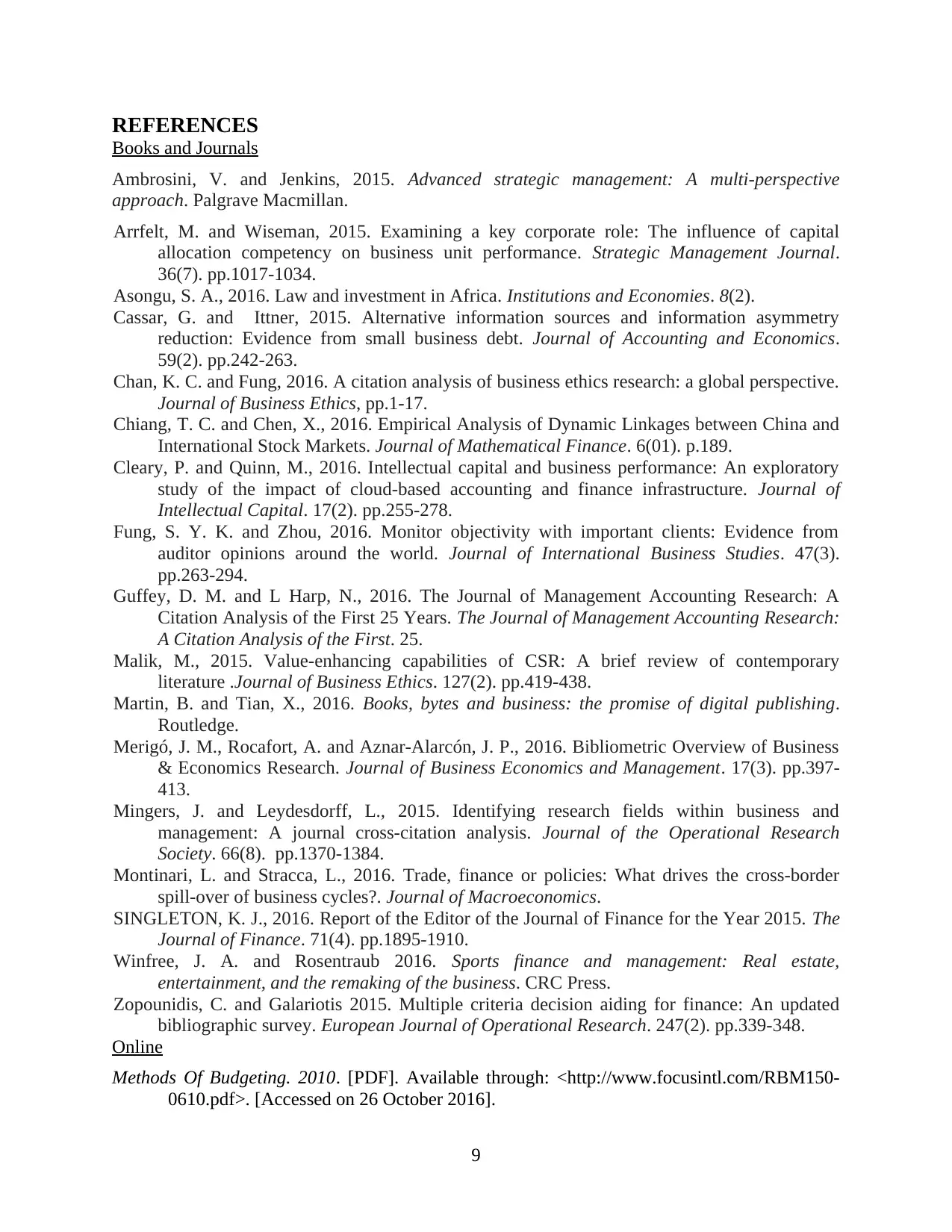
REFERENCES
Books and Journals
Ambrosini, V. and Jenkins, 2015. Advanced strategic management: A multi-perspective
approach. Palgrave Macmillan.
Arrfelt, M. and Wiseman, 2015. Examining a key corporate role: The influence of capital
allocation competency on business unit performance. Strategic Management Journal.
36(7). pp.1017-1034.
Asongu, S. A., 2016. Law and investment in Africa. Institutions and Economies. 8(2).
Cassar, G. and Ittner, 2015. Alternative information sources and information asymmetry
reduction: Evidence from small business debt. Journal of Accounting and Economics.
59(2). pp.242-263.
Chan, K. C. and Fung, 2016. A citation analysis of business ethics research: a global perspective.
Journal of Business Ethics, pp.1-17.
Chiang, T. C. and Chen, X., 2016. Empirical Analysis of Dynamic Linkages between China and
International Stock Markets. Journal of Mathematical Finance. 6(01). p.189.
Cleary, P. and Quinn, M., 2016. Intellectual capital and business performance: An exploratory
study of the impact of cloud-based accounting and finance infrastructure. Journal of
Intellectual Capital. 17(2). pp.255-278.
Fung, S. Y. K. and Zhou, 2016. Monitor objectivity with important clients: Evidence from
auditor opinions around the world. Journal of International Business Studies. 47(3).
pp.263-294.
Guffey, D. M. and L Harp, N., 2016. The Journal of Management Accounting Research: A
Citation Analysis of the First 25 Years. The Journal of Management Accounting Research:
A Citation Analysis of the First. 25.
Malik, M., 2015. Value-enhancing capabilities of CSR: A brief review of contemporary
literature .Journal of Business Ethics. 127(2). pp.419-438.
Martin, B. and Tian, X., 2016. Books, bytes and business: the promise of digital publishing.
Routledge.
Merigó, J. M., Rocafort, A. and Aznar-Alarcón, J. P., 2016. Bibliometric Overview of Business
& Economics Research. Journal of Business Economics and Management. 17(3). pp.397-
413.
Mingers, J. and Leydesdorff, L., 2015. Identifying research fields within business and
management: A journal cross-citation analysis. Journal of the Operational Research
Society. 66(8). pp.1370-1384.
Montinari, L. and Stracca, L., 2016. Trade, finance or policies: What drives the cross-border
spill-over of business cycles?. Journal of Macroeconomics.
SINGLETON, K. J., 2016. Report of the Editor of the Journal of Finance for the Year 2015. The
Journal of Finance. 71(4). pp.1895-1910.
Winfree, J. A. and Rosentraub 2016. Sports finance and management: Real estate,
entertainment, and the remaking of the business. CRC Press.
Zopounidis, C. and Galariotis 2015. Multiple criteria decision aiding for finance: An updated
bibliographic survey. European Journal of Operational Research. 247(2). pp.339-348.
Online
Methods Of Budgeting. 2010. [PDF]. Available through: <http://www.focusintl.com/RBM150-
0610.pdf>. [Accessed on 26 October 2016].
9
Books and Journals
Ambrosini, V. and Jenkins, 2015. Advanced strategic management: A multi-perspective
approach. Palgrave Macmillan.
Arrfelt, M. and Wiseman, 2015. Examining a key corporate role: The influence of capital
allocation competency on business unit performance. Strategic Management Journal.
36(7). pp.1017-1034.
Asongu, S. A., 2016. Law and investment in Africa. Institutions and Economies. 8(2).
Cassar, G. and Ittner, 2015. Alternative information sources and information asymmetry
reduction: Evidence from small business debt. Journal of Accounting and Economics.
59(2). pp.242-263.
Chan, K. C. and Fung, 2016. A citation analysis of business ethics research: a global perspective.
Journal of Business Ethics, pp.1-17.
Chiang, T. C. and Chen, X., 2016. Empirical Analysis of Dynamic Linkages between China and
International Stock Markets. Journal of Mathematical Finance. 6(01). p.189.
Cleary, P. and Quinn, M., 2016. Intellectual capital and business performance: An exploratory
study of the impact of cloud-based accounting and finance infrastructure. Journal of
Intellectual Capital. 17(2). pp.255-278.
Fung, S. Y. K. and Zhou, 2016. Monitor objectivity with important clients: Evidence from
auditor opinions around the world. Journal of International Business Studies. 47(3).
pp.263-294.
Guffey, D. M. and L Harp, N., 2016. The Journal of Management Accounting Research: A
Citation Analysis of the First 25 Years. The Journal of Management Accounting Research:
A Citation Analysis of the First. 25.
Malik, M., 2015. Value-enhancing capabilities of CSR: A brief review of contemporary
literature .Journal of Business Ethics. 127(2). pp.419-438.
Martin, B. and Tian, X., 2016. Books, bytes and business: the promise of digital publishing.
Routledge.
Merigó, J. M., Rocafort, A. and Aznar-Alarcón, J. P., 2016. Bibliometric Overview of Business
& Economics Research. Journal of Business Economics and Management. 17(3). pp.397-
413.
Mingers, J. and Leydesdorff, L., 2015. Identifying research fields within business and
management: A journal cross-citation analysis. Journal of the Operational Research
Society. 66(8). pp.1370-1384.
Montinari, L. and Stracca, L., 2016. Trade, finance or policies: What drives the cross-border
spill-over of business cycles?. Journal of Macroeconomics.
SINGLETON, K. J., 2016. Report of the Editor of the Journal of Finance for the Year 2015. The
Journal of Finance. 71(4). pp.1895-1910.
Winfree, J. A. and Rosentraub 2016. Sports finance and management: Real estate,
entertainment, and the remaking of the business. CRC Press.
Zopounidis, C. and Galariotis 2015. Multiple criteria decision aiding for finance: An updated
bibliographic survey. European Journal of Operational Research. 247(2). pp.339-348.
Online
Methods Of Budgeting. 2010. [PDF]. Available through: <http://www.focusintl.com/RBM150-
0610.pdf>. [Accessed on 26 October 2016].
9

Yvanovich, R., 2012. Traditional budgeting approach: advantages and disadvantages. [Online].
Available through: <http://blog.trginternational.com/bid/162036/Traditional-budgeting-
approach-advantages-and-disadvantages>. [Accessed on 26 October 2016].
10
Available through: <http://blog.trginternational.com/bid/162036/Traditional-budgeting-
approach-advantages-and-disadvantages>. [Accessed on 26 October 2016].
10
⊘ This is a preview!⊘
Do you want full access?
Subscribe today to unlock all pages.

Trusted by 1+ million students worldwide
1 out of 12
Related Documents
Your All-in-One AI-Powered Toolkit for Academic Success.
+13062052269
info@desklib.com
Available 24*7 on WhatsApp / Email
![[object Object]](/_next/static/media/star-bottom.7253800d.svg)
Unlock your academic potential
Copyright © 2020–2025 A2Z Services. All Rights Reserved. Developed and managed by ZUCOL.




